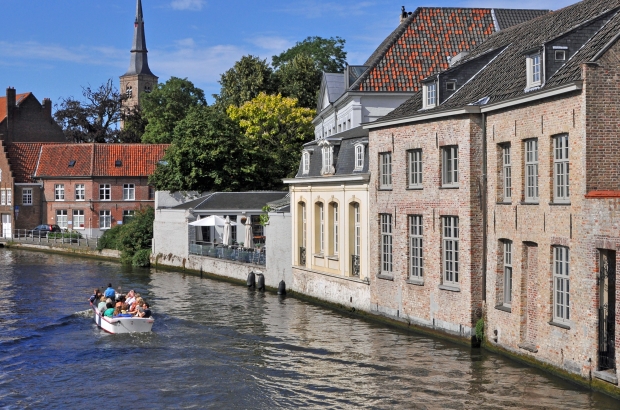- Daily & Weekly newsletters
- Buy & download The Bulletin
- Comment on our articles
Belgium steps up measures to combat overtourism
Dealing with hordes of tourists is an age-old problem for France and Italy – and now several attractions in Belgium are attempting to do the same.
France is now imposing quotas on popular sites such as Mont-Saint-Michel and the Calanques national park, and Italy is planning to introduce a tourist charge for daytrippers entering Venice as well as the overnight tax.
Now Belgium, already obliged to introduce a parking ban in the Hautes-Fagnes region during the Covid pandemic, is facing similar difficulties.
“We are trying to redirect tourists towards places where there are fewer people. On the motorway, posters already warn visitors,” Claudine Legros, responsible for marketing and communication at the Eastern cantons' tourist agency, told RTBF.
In Durbuy, billed as “the world’s smallest city”, Pablo Docquier, alderman for tourism also spoke of mass tourism.
The town is seeing a large number of mainly Dutch-speakers buying houses to transform them into second homes or gîtes.
“That has really affected some residents who are wondering if their children will still be able to buy here,” he said.
However, while quotas have been set to limit the amount of tourist accommodation in comparison to the number of inhabitants, the liberal MP insisted that, “we are not going to set up checkpoints saying, ‘you cannot enter here,” even in peak summer or during the Christmas market.
Unsurprisingly it is Bruges, the so-called Venice of the North, where overtourism is most acute.
In summer, visitor numbers can reach 60,000, nearly half the town’s population (118,509 people recorded in 2021). Indeed, one holiday letting agency survey has placed Bruges in Europe’s top three visited towns, alongside Dubrovnik and Venice.
Questioned by De Standaard newspaper, inhabitants voiced their frustration with the noise of suitcases on wheels, crowds and the invasion of tourist shops. “The balance between life, work and tourism is lost here,” said one resident.
Bruges, like Marseilles and Amsterdam – which moved its ‘I Love Amsterdam’ sign from the Rijksmuseum to outside the city – is also engaging in "demarketing", said Alain Decrop, tourism economics expert.
The Flemish town has stopped its advertising for daytrippers at airports and Flemish towns and imposed restrictions so that only two ships can dock at the same time at nearby Zeebrugge.
A short train ride away, Ghent is beginning to experience the same problems, tourist alderman Bram Van Braeckevelt said.
"In the past, the more tourists we had the better," he said. "Now we are paying attention. We do not want to become Venice, Bruges or Amsterdam."
Braeckevelt cited warnings made in 2019 that at this rate the town would go from one to two million stays a year, without counting daytrippers. Already in 2022, the town accommodated 1.5 million people.
Ghent has therefore put measures in place to halt the crowds. From 2019, it has not been possible to change a house into a holiday home, and from March 2023, tourist taxes to stay in houses or holiday flats have doubled in comparison to those paid in hotels.
The town is also proposing alternative tourist itineraries in the hope of stopping crowds in the centre.
In short, the aim is to make Ghent, “a town with tourists instead of a town of tourists. We want fewer ‘selfie tourists’ and more ‘pyjama tourists’ who stay two or three nights,” Braeckevelt said.
With this in mind, Ghent tourist office’s new promotional video on its website is, if at first nothing if not surprising, announces: “Don’t come to Ghent. The town is just too, too beautiful, durable and with a rich history.
"It has delicious food; the people are too nice, and the shops are too fantastic. There is so much to do and see… so don’t come to Ghent… without your pyjamas."
The aim is to strike a balance between managing the influx of tourists and enjoying the economic benefits they bring. Ghent employs 7,000 people in the tourist sector for example.
The region’s tourist centre Toerism Vlaanderen is also focusing on “pyjama tourists” instead of “selfie tourists” and trying to attract people towards less well-known areas of the province.
Problems are less marked in Wallonia, where the tourist agency Visit Wallonia is aiming, and successfully so, to regain the level of tourism seen before the pandemic in 2019. The flux of tourists to Brussels is also seen as manageable.
Meanwhile, the United Nations agency responsible for promoting “responsible, sustainable and universally accessible tourism”, the World Tourism Organisation, said in its January 2023 World Tourism Barometer that while Covid-19 halted the massive rise of international tourists (from 25 million in 1950 to 1.3 billion in 2017), this year, visitor numbers could reach from 80% to 95% of pre-Covid levels.
The WTO also notes that some 95% of international travellers visit less than 5% of the world.

















